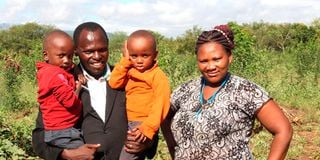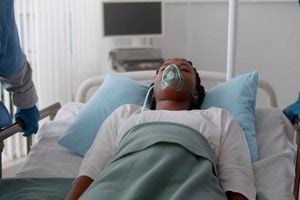Innovations turn the tide on Kenya’s maternal mortality crisis

Ambrose Mutiso and his wife Patricia with their sons at Kasalani Village in Makueni County on April 2, 2024. Mr Mutiso leads a team of men who openly advocate for men to be more involved in promoting hospital deliveries as one of the ways of reducing maternal deaths.
What you need to know:
- Postpartum haemorrhage is the leading cause of maternal mortality. Each year, about 14 million women experience PPH, resulting in 70,000 maternal deaths globally.
Ambrose Mutiso believes he has mastered the art of commanding attention from his audiences. Every time he steps onto the stage, he ensures all eyes—and ears—are on him.
“In classrooms, you will often hear teachers shouting, “Keep quiet!” He says.
“It’s all the same thing. I find words to keep them engaged.”
His favourite opening line? “How many men here have ever accompanied their wives to an antenatal clinic?”
The room almost always erupts in laughter, some chuckling in embarrassment and others murmuring in disbelief: Ata yu? (how now?)
***
Four years ago, when the world was in the throes of the Covid-19 pandemic, Mr Mutiso’s wife, Patricia, delivered a set of twins weeks before her expected delivery date.
The babies were put in an incubator at the Makueni Level Five Hospital, and due to pandemic restrictions, Mutiso, a shopkeeper by trade, was barred from holding them. Instead, he spent his time pacing the hospital corridors, chatting with his wife, then heading home.
However, Mutiso didn’t realise the real challenge would come after the boys were discharged.
“For the next three months, I was supposed to actively participate in keeping them alive through kangaroo mother care(KMC).”
The method involves prolonged skin-to-skin contact between an adult and a baby to keep them warm and increase their chances of survival. Diverse research shows that KMC leads to a significant reduction in newborn deaths, especially in low-income countries, where many health facilities lack incubators for preterm babies.
The hospitalwarned Mutiso and his wife to make sure the babies didn’t lose weight. If they did, they would need to return for re-admission.
“I couldn’t let that happen so I did everything I could to take care of the babies. Thankfully, they thrived. The health workers were so impressed, they even threw us a party. I don’t know what would have happened to them if I had abandoned my wife during that period. It became clear to me that men have a big role in fostering safe motherhood,” Mr Mutiso says.

Lilian Mumbua, a nurse at the Mother and Child Unit in Makueni County, demonstrates how to use a blood collecting drape at the hospital on October 16. This is one of the innovations the hospital uses to manage postpartum hemorrhage.
His story was not unique in the village. There were countless others—some of heartbreaking loss, others of near misses, and a few, like his, of quiet triumph.
The realisation inspired him to rally his peers and each driven by their personal experiences, formed a group dubbed the “Kasalani Father to Father Group.”
“We are a group of 13 men drawn from different fields, and we meet once every month to discuss the welfare of our wives and other women in the county. Our mission is to promote safe motherhood by raising awareness among ourselves and our networks,” he offers.
A goat scheme sits at the centre of the sustainability plan of Mr Mutiso’s chama. “As we advise couples to have a birth plan which has a component of emergency preparedness, we have moved to insulate ourselves from the financial shocks associated with child deliveries. Each member contributes Sh250 per month towards the purchase of a goat. It is like a merry-go-round whereby each member benefits on a particular month. A member is free to sell the goat to offset maternity bills,” offers Shadrack Masila,” a trained medic and the group’s vice-chairperson.
Deadliest time
The stories they share when they gather or speak to members of the community are those that stem from complications that women experience during pregnancy and after delivery.
Among the most dangerous is postpartum haemorrhage (PPH), a condition that can lead to life-threatening blood loss in new mothers. It not only endangers lives but also strains healthcare systems, especially in regions with limited medical resources.
Even in regions with better access to healthcare, the risks remain significant. “I have witnessed how quickly a manageable situation can spiral into a life-threatening emergency, regardless of location,” says Dr Lauryn Mengesa, director of Akira Legacy and lead obstetrician and gynaecologist at The Wellness Practice in Nairobi County.
“I read multiple research that the deadliest time for mothers is after the baby is born, and I had an almost out-of-body experience with the delivery of my second baby in 2019. I had a successful delivery with my firstborn. Like any other mother, I looked forward to delivering my second without any hiccups, but I bled excessively and ended up requiring blood transfusion,” she remarks.
“It all started towards the end of the delivery process. The doctors said they were struggling to get the baby out, and they almost resorted to a vacuum extraction delivery, which involves applying suction and traction to the baby’s head to help pull it out as the mother pushes. She was a heavy baby and weighed four kilogrammes,” she offers.
This experience made postpartum haemorrhage a deeply personal issue for her, and it is one of the subjects she is keen to address in her clinic.
“When we talk about PPH, it means that a woman has delivered a baby, and now they’re bleeding in a way that is excessive. There’s like a normal amount of bleeding that we expect naturally because of the natural process of labour, but when it goes beyond a certain limit, then it becomes a problem. If it’s a normal delivery, then above 500ml of blood would be considered too much in postpartum haemorrhage. If it’s delivery through surgery — caesarean section — losing more than a litre of blood would be considered postpartum haemorrhage,” she offers.
Deaths globally
According to the World Health Organization (WHO), PPH is the leading cause of maternal mortality. Each year, about 14 million women experience PPH, resulting in 70,000 maternal deaths globally. Even those who survive, WHO notes, could end up with a lifelong reproductive disability.
In April, the Ministry of Health (MOH) named Makueni among 12 counties with high risks of postpartum haemorrhage. Other counties that reported high cases included Tana River, Garissa, West Pokot, Elgeyo Marakwet, Machakos, Homabay, Siaya, Wajir, Kilifi, Murang’a, Makueni, Migori and Turkana.
Dr Edward Serem, head of Reproductive and Maternal Health at MOH, then said that about 5,000 women die during childbirth. Government data show that Makueni County lost 22 women to postpartum haemorrhage during childbirth in 2022 and 13 in 2023.
“The main causes we have narrowed down is the uterus stretching so much during the pregnancy and delivery process or you had a very big baby, or there was too much amniotic fluid,” says Dr Lauryn.
If a woman gets a tear on the cervix or on the walls of the vagina, they can end up bleeding. And the more they bleed, the more blood they’re losing. “Then there are people who naturally have conditions that make them unable to clot properly,” she offers.
According to Dr Laura Oyiengo, head of Maternal and Newborn Health at Unicef-Kenya, some of the risk factors start before one is pregnant.
“We also need to look at nutrition because there is a correlation between food insecurity and postpartum haemorrhage. We are finding that some women have anaemia, which is when your blood levels are low. In some parts of the country, some people do not have the recommended quantity and quality of meals and don’t receive iron supplements,” she remarks.
“By the time they are going into labour, they are already anaemic, which predisposes them to PPH.”
“Should women be dying of a condition that we can prevent?” Poses Prof Moses Obimbo, an associate professor at the University of Nairobi and the secretary of the Kenya Gynaecological and Obstetrical Society.
He spoke to Healthy Nation on the sidelines of the inaugural run dubbed ‘Run for Her, which took place on October 6 in Nairobi, to raise awareness on postpartum haemorrhage. “We came together as health workers and other stakeholders and decided that we needed to sensitise other public healthcare workers and policymakers that there is a problem in the room and we really need to face it,” he says.
“By spotlighting it, through a four-prong approach, which encompasses research and innovations, we should be able to get more resources invested towards addressing PPH. The health professionals are championing, through institutions like MOH, for the World Health Organization to guarantee us a World PPH day to commemorate all the families and women who have suffered as a result of PPH,” he says.
New innovations
Globally, new innovations are being developed to combat this life-threatening condition.
“There are simple tests that we can do, like a small machine that is able to check your blood levels even before delivery. It is something accessible to even very small and remote facilities. It is also inexpensive,” Shares Dr Lauryn.
An ongoing nationwide campaign to address maternal deaths by combating excessive bleeding during childbirth has seen Makueni County benefit from medication and other interventions. The programme dubbed ‘Accelerating Measurable Progress and Leveraging Investments for Postpartum Haemorrhage Impact’ is spearheaded by the Kenya Obstetrical and Gynaecological Society and implemented by the government and Jhpiego.
The programme has revamped the Makueni County health system by supplying medication for managing postpartum haemorrhage. “We are collaborating with Makueni County to introduce new medicines that have been proven to work well to prevent and treat excessive bleeding after birth. The project will distribute medicine to the county for the next three years. These are heat-stable carbetocin, tranexamic acid, and misoprostol,” says Michael Mwiti, the manager in charge of the programme combating PPH at Jhpiego.
Uterine massage
Carbetocin, for instance, does not require refrigeration and can be used in areas that are not connected to the national electricity grid. According to the Kenya Medical Supplies Agency, a dose goes for Sh92.
Zero cases
Makueni Health Executive told Healthy Nation that the number of deaths related to postpartum haemorrhage in the county has drastically decreased to recording zero cases between January and June since they adopted maternal health influencers and equipment that monitors blood loss.
“We did not lose any mother around delivery time in January and February,” Dr Musila told Healthy Nation in April.
The Makueni Mother and Child Hospital, a level four hospital set up by the county government to enhance maternal and child healthcare, is among 36 public hospitals in the county that use a blood collection drape on all vaginal deliveries, which is calibrated to monitor the blood loss during childbirth. It is calibrated up to 1600 millilitres.
“The drape does not require electricity. Once it fills up to 300 millilitres, it triggers a warning that the bleeding could be abnormal. Once it reaches the 500-millilitre mark, which is the theoretical definition of postpartum haemorrhage, we quickly administer an E-MOTIVE bundle to address the problem,” says Lillian Mumbua, a nurse midwife at the facility.
The E MOTIVE bundle is a set of interventions which serve as the first line of defence in managing PPH as recommended by WHO. It includes uterine massage, medication for contracting the uterus and intravenous fluids.
Dr Musila posits that the reduction in mothers requiring interventions like blood transfusion has reduced pressure on the county’s blood bank.
“But, there is a lot that still needs to be done,” the Unicef representative says. “We really need to improve on the medicines available and improve on the quality of care accorded to women. If a woman is in labour and then develops a complication that ends up in excessive bleeding, we need to have the right tools, the right medicine and blood in our blood banks.”
In many parts of the country, hospitals are grappling with a severe shortage of blood, leaving desperate families with no option but to find donors themselves before their loved ones can receive life-saving transfusions. Patients in critical condition, including those suffering from excessive bleeding, are often forced to wait for extended periods—sometimes more than one day—while relatives scramble to secure enough blood to replenish the blood used from the limited supply available.
Ronald Otieno,35, lost his wife to excessive bleeding in October 2020.
“I remember the doctors telling me that my wife required blood transfusion and before it happened, I had to look for individuals to come and donate. It was very challenging because of the various restrictions that came with the pandemic, and it took two days before getting blood donors. Unfortunately, she passed on a week later,” says the resident of Nairobi.
Like Mr Mutiso, the single father of one has started to speak out about his experience to create more awareness about excessive bleeding after birth. “I didn’t know about it before it happened to me, but I want to ensure that other men are aware of how life-threatening it can be and rally for stronger health systems, to prevent more deaths,” he offers.
Dr Laura says Unicef has introduced the Non-pneumatic Anti-Shock Garment at a global level. “It is like a pressure suit that astronauts wear when they go to space. So when women start bleeding, it squizzes to enable blood to flow from one area to another by exerting pressure on the body. It buys time to facilitate movement from one facility to another.
“We also have another innovation called uterine balloon tamponade. You put it inside the woman’s womb. It presses on the walls and by that pressure, it closes off the blood vessels and stops the bleeding.”
[email protected], [email protected]






